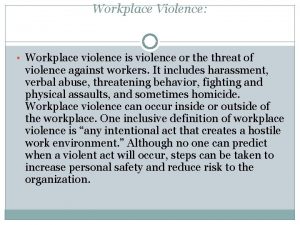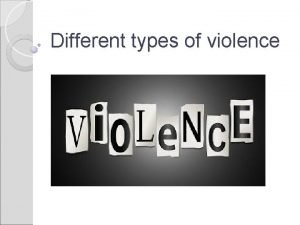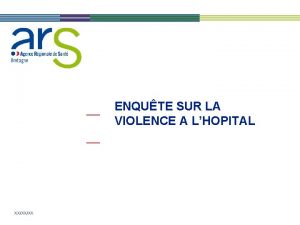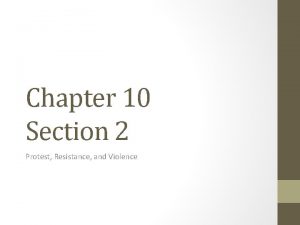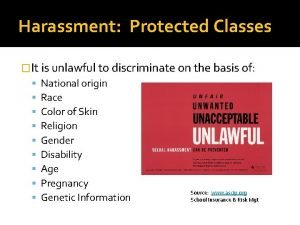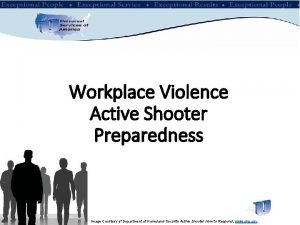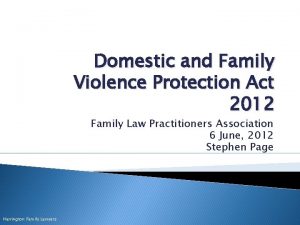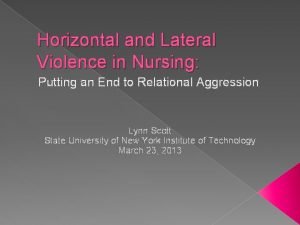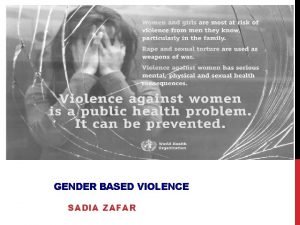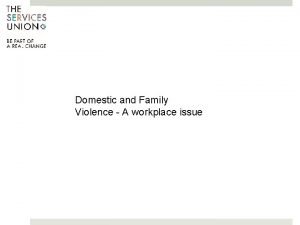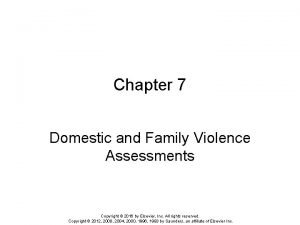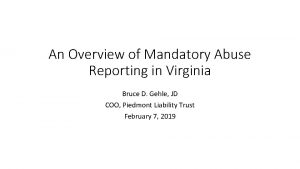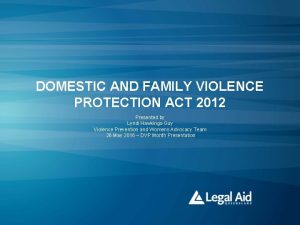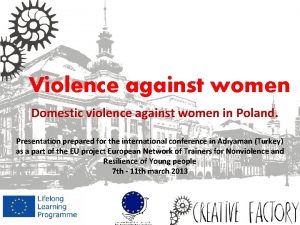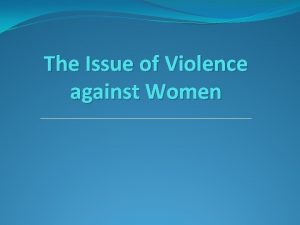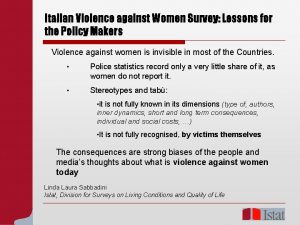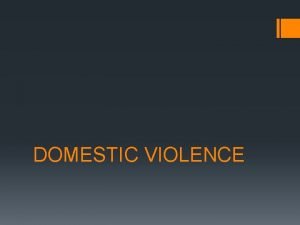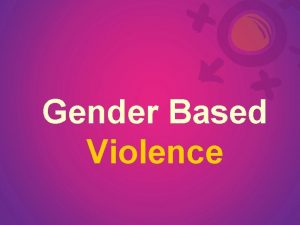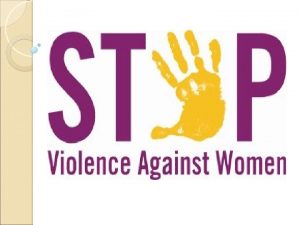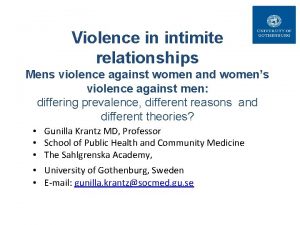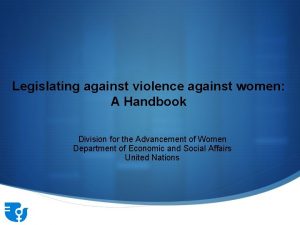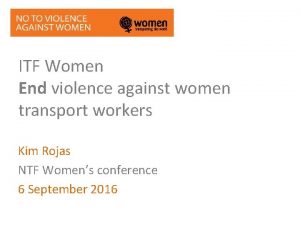Italian survey on violence against women Maria Giuseppina














































- Slides: 46

Italian survey on violence against women Maria Giuseppina Muratore Work Session on Gender Statistics Geneva 19 October 2004

Violence against women exists in all societies, in all cultures and religions and in all social classes. The problem Italian background Italian steps in IVAWS Questionnaire and methodology revision The Pilot Survey To understand it, we have to accept it as a dimension of “normal relationaships”. . .

Violence and, above all, violence in the family is still an underreported an understudied social problem Ø Women rarely disclose what has happened to them and even more rarely Ø they report to the police Ø they seek for help in the crisis centres or in other social services Official data gathered with criminal statistics do not provide enough evidence on violence against women. Especially in cases of domestic violence

From the Italian Victimization survey it emerges that • The rate of sexual violence reported to the police is absolutely low 12, 3% • it increases to 15, 5% when the offender is a stranger • it decreases to 4% if the offender is a known person % of violence reported Type of violence During the life course In the last three years Rape 17, 8 32, 8 Attempted rape 6, 9 1, 2 Source: Citizen’s Safety Survey 1997 -1998

To learn about violence against women (with regard to its prevalence, incidence rate and nature) Information should be gathered from those directly involved (i. e. women), who are asked about their lives Only dedicated surveys on domestic violence can achieve this aim

Surveys on violence against women are complex: need to address sensitive issues Need methodological and procedural dedicated tools that help women – to disclosure and – beforehand to recognize what is violence in her life.

The research aims to address several aspect of violence against women: • Prevalence and incidence rate of different types of violence a specific attention has domestic violence by current or former partner – – psychological economical physical sexual • Characteristics of those involved and characteristics, consequences and costs of violence, the history of violence • Risk and protective factors related to individuals as well to socio-demographical domain • The every day life context in which violence can arise

The Italian Experience and the focus on Domestic Violence • This dedicated survey is the first one of this kind in Italy • Since 2001 Istat and the Department of Equal Opportunities began to address the issue • And at the same time, in 2000 -2001 began the IVAWS Project coordinated by Heuni Unicri Statistics Canada • Project to whom Italy (through Istat ) partecipate » But some criticism

Some doubts about the Italian context: • Survey Feasibility: – are women and the comunity ready to deal with violence matter? • Women availability: – Are women ready to answer … The problem Italian background Italian steps in IVAWS Questionnaire and methodology revision The Pilot Survey • Women disclosure: – Are women ready to open themselves and to speak about their violence experience (if any) Need to study more and deeply the questionnaire and the methodology so…. .

IVAWS in Italy: steps in summary • Ivaws pilot test of the first version of the questionnaire on a rather small number of women (78) (May 2002) • Qualitative phase The problem – Focus group and interviews to key professionals (October 2002 – April 2003) Italian background Italian steps in IVAWS Questionnaire and methodology revision The Pilot Survey Questionnaire and methodology revision • Pilot survey (April – July 2004) • Full fledged surve on 30. 000 women 2005

Procedure of the qualitative phase Sample: 6 Focus Groups • Workers in shelters for women victims of violence (2 groups) • Women victims of domestic violence (2 group) • Women from the community (1 group) • Interviewers who have already had experience in victimisation surveys (1 group) Plus 1 group interview with legal and social experts working in the field of violence against women

Procedure • Each focus group was conducted with two psychologist and was video/audio recorded and then transcribed • According to the group, different questions were posed, with the aim of learning about: Content of the questionnaire Procedural methods

Content of the questionnaire • What is domestic violence (especially psychological violence) • Different expressions of violence (Economical violence, Psychological violence, Physical violence, Sexual violence) • How women deal with violence, which is their perception • Early precursors of dv, cycle violence • The attribution of responsibility • Risk factors • Consequences of violence • The role of children or of other push in reporting or going out of violence • Prejudices and stereotypes

Procedural methods • • How to gain women’s faith (for the training of interviewers) Feelings experienced from women as regards the survey Characteristics of interviewers The emotional impact on interviewers What to ask and how Wording and sequence How to introduce the study Length of the interview

Some results about contents and procedural methods

Psychological violence • Most forms are not evident (threatening, downgrading, intimidation, limitation of freedom, excessive jealousy) • Women rarely recognized it as violence • Furthermore it’s not visible from a social point of view, so it’s difficult for women to speak about it and give vent to owns feeling • It’s culturally accepted that a woman has not to be autonomous thoughts, that she has to do what her husband is asking; or that she is or thinks to be what her husband tell her. • It could be measured considering the different aspects of the daily life

IVAWS questionnaire • 1 2 3 4 5 6 7 8 9 10 Now, I would like to ask about some situations that can happen in relationships. Would you say your husband/partner/ boyfriend: Gets angry if you speak with other men? Is supportive towards your work or studies or other activities taking place outside the home Tries to limit your contact with family and friends? Follows you or keeps track of your whereabouts in a way you find controlling or frightening? Calls you names, insults you or behaves in a way to put you down or to make you feel bad? Damages or destroys your possessions or property or your animals? Is constantly suspicious that you have been unfaithful? Insists on knowing who you are with and where you are at all times? Harms or threatens to harm your children? Harms or threatens to harm someone else close to you?

from the focus group 11 Is he willing to talk with you and exchange your opinions? 12 He criticizes you for the way you look, dress, for instance by telling you that you are not very attractive, ugly, inadequate? 13 He criticizes you for the way you raise your child, look after the house or cook, for example by telling you that you are not a good mother or that you are incompetent 14 He checks how much you spend? 15 He forces you what to wheare, how to arrange your hair, how to behave in public?

Economic violence • no access to bank account • no info on family income • not allowed to work from the focus group E 18 Do you have any bank or post account registered under both your name and your husband/cohabiting partner/boyfriend? E 19 Do you have a credit card, a cash card, or cheque book that you can use on your joint account or on the account in your husband/cohabiting partner/boyfriend name?

Risk/escalating factors • • • Marriage Pregnancy Social-family events Different perception on children education Each time the woman shows she wants to ‘leave’ – flee. from the focus group G 32 Do you recall any particular circumstance that irrupted caused the violence of your partner? Other questions on violence history

Consequences • • • Lower self-esteem Guilt feelings Depression Loss of faith in relationship Sense of insecurity Not talking to others G 13 D 15 D 30 from the focus group Subsequently to this episode, did you have to give up your daily routine? Subsequently to this episode, did you have to stay away from work? Subsequently to this episode, has something changed in your attitude?

Social context/attitudes • Violence by partners enables gradually to isolate from the outside world – Families that want to protect themselves or they feel they can not provide any support. – A working activity that has been interrupted or prevented. – Absence of any friendship network • • • Role of stereotypes that affect women and those involved Denial/minimisation of severity Indifference Not really serious if women don’t leave or don’t report Private matters from the focus group B 19 D 28 Do you have friends, relatives, or other people with whom you can talk of yourself, who you trust on whom you can rely if needed? …… did you ever talk to someone else about what has happened ……?

Wording and the questionnaire design • Funnelling effect • Different types of crime analysed are presented with a screening procedure which helps to focus the attention on both the type of violence as well as on all possible authors • The language adopted should be clear and not redundant • Questions should also adopt sentences not using jargons or other unclear questions. • No name it ‘VIOLENCE’ • The type of violence is defined in a way that women can remember and reflect their lives as if in a mirror • Ask gradually about violence • The questions measuring violence should be included gradually

Questionnaire revision • B 16 –B 21 – Ask questions on the every day life, leisure time, social networks, health, before those on violence To Go in gradually into the relationship with the female interviewer • C, E or Ebis, F The problem Italian background Italian steps in IVAWS Questionnaire and methodology revision – Repeat the screening of physical and sexual violence for the actual and the former partner We decided to reintroduce again the screening on partners and former partners to facilitate disclosure • Posticipation in E section – We inserted the questions on violence from the partner in the section on the partner’s characteristics, after having asked about the relationship and the psychological violence battery • D - More details about last episode of violence The Pilot Survey • G - More details about last episode violence and history violence

Questionnaire • • • The problem Italian background Italian steps in IVAWS Questionnaire and methodology revision A. Control form B. Marital status and respondent characteristics C. Experience of violence by non partners D. Non-partner victimisation report E. Characteristics of current intimate partner and partner experience of violence • Ebis. Characteristics of the last partner and experience of violence (if there isn’t an actual partner) • F. Experience of violence by previous partners and characteristics of the violent previous intimate partner • G. Partner/previous partner victimisation report • H. Mother and partner abuse history and victimisation • I. Conclusion The Pilot Survey • L. Quality section childhood

Methodology revision • How to approach the woman • Characteristics of interviewers • Context of the interview The problem More attention on: Italian background Survey organization Italian steps in IVAWS Interviewers selection Questionnaire and methodology revision Interviewers training Women Safety The Pilot Survey Interviewers burn out

The pilot survey Survey organization Interviewers selection Interviewers training The problem Italian background Italian steps in IVAWS Questionnaire and methodology revision The Pilot Survey Sample Monitoring phase Results of the survey quality

Survey organization Type of interviewers: two groups – one group with more expertise in the CATI method (8) – a second group of women working in shelters for battered women (7) • Type of interviewer’s payment – hours worked (included the payment during the training phase) The Pilot Survey: Survey organization Interviewers selection Interviewers training Monitoring phase Sample Results of the survey quality • Timetable of interviews – from 9 am to 9 pm, Monday to Friday – from 9 am to 7 pm on Saturday • Possibility to make an appointment and to call to a mobile phone – to augment privacy • Toll free number and mailing • Reasercher team – psichologists during the training and the collection data phase

Interviewers Selection Interviewers were chosen based on the following: The Pilot Survey: Survey organization Interviewers selection Interviewers training Monitoring phase Sample Results of the survey quality – Female; – Minimum 24 years old; – Comfortable discussing issues related to violence against women; – Sensitivity and maturity; – Professional experience in CATI surveys as well as in dealing with cases of violence (according to the type of the group); – Prior experience in handling similar sensitive research studies; – Listening skills, empathy, no counselling; – Probing, no judgment; – Warm tone of voice that helps creating a positive climate; – Capacity to keep adequate detachment; – Skills to elaborate own emotions and to handle unexpected situations; – Motivation

Interviewers Training 6 days of theorical training From 9 am to 2 pm The Pilot Survey: Survey organization About the suject - sexual violence - domestic violence - emotional abuse and psychological violence - risk factors - consequences - how to recognize it. . . . About the Methodology - how to read the question - how to codify the answer - the sample - the contact procedure. . . About the emotion - how to handle them - no counsellor - warm tone of voice, communicating skills - learning the detachment and empaty. . . . Interviewers selection Interviewers training Sample Monitoring phase Results of the survey quality

Interviewers Training Traning instrument: Lessons, videos, practice, roleplayings …. • 2 days of technical training The Pilot Survey: Survey organization – From 9 am to 5. 30 pm how to handle with: Interviewers selection Interviewers training • CATI system Monitoring phase • the appointment technique Sample • the recall system Results of the survey quality • Trial calls

Monitoring phase • Help assistance during the entire collection phase • Every day quality indicators (refusal rate, contact/non contact rate, appointment rate, average lenght. . . ) The Pilot Survey: Survey organization Interviewers selection Interviewers training Monitoring phase Sample Results of the survey quality – – For interviewers For interviewer group For time of calls At local level • Debriefing with interviewers every week • Psychological support

Sample 1. Design - two stages random sample stratified at the first stage 2. First stage - households present on the ufficial list of telephone subscribers 3. Stratification criterion The Pilot Survey: Survey organization Interviewers selection Interviewers training Monitoring phase Sample Results of the survey quality - Stratus variable: region and type of municipality 4. Size - 1. 000 household selected all over the country and a sample of 5000 households for possible substitution (territorial criterion of proximity) 5. Second stage - Women aged 16 -70 years old 6. Selection criterion - Random selection between eligible women

Sample Actual and past marital status At the time of the interview: 75, 8% women were married 2, 2% had a partner more uxorio 7, 7% had a boyfriend The Pilot Survey: Survey organization Interviewers selection Interviewers training Monitoring phase Sample Results of the survey quality 85, 7% (819) women have a partner now section E In the past 3, 3% (31) women had only a partner in the past section Ebis 44, 1% (419) women had partners also in the past section F

Calendar of the survey • Questionnaire Informatization (February – March 2004) • Interviewer selection (March 2004) • Test of the Questionnaire (March 2004) The Pilot Survey: • Training (April 2004) • Mailing (April 2004) Sample • Trial calls and revision of the indicator system (April 2004) Results of the survey quality • Collection phase (26 April - 9 July 2004) Survey organization Interviewers selection Interviewers training Monitoring phase

Results about the survey quality and the feasibility of the survey Some numbers: – Phone calls: – Telephone number contacted: – Telephone number not in target: (no eligible households 543) 24687 2840 783 Some rates: The Pilot Survey: Survey organization Interviewers selection Interviewers training – – – Cooperation rates Household refusal rate Refusal rate of selected person Interruption rate Average lenght 61, 1% 18, 5% 3, 8% 2, 7% 28, 8 minutes <15 12, 9% 15 -30 62, 2% 31 -45 19, 9% 46 -60 3, 8% 61 -70 1, 1% 71 -80 0, 1% Monitoring phase Sample Results of the survey quality Lenght in classes

Results about the survey quality and the feasibility of the survey – There are many differences among the two group of interviewers 21 MAY Refusal rate The Pilot Survey: Survey organization Interviewers selection Interviewers training Monitoring phase Sample Results of the survey quality Refusal of selected person Interruption rate Lenght Interviewers from shelters 7, 9 1, 4 0, 2 32 Cati professionist interviewers 10, 1 1, 7 1, 5 26 – Against every expectation, interviewers from shelters obtained more interviews than the other ones – They were “new” for this work, they didn’t use dangerous authomatisme to maximize their work, each call was an adventure – They are able to conquer the household, to put at own ease the respondent, to value her

Results about violence rate The interviewers from shelter: – Read slowly and entirely the questions – Gave time to reflect and to answer to the interviewees – create a confiance climate with women The Pilot Survey: This means more ability to capture violence - Women disclosure themselves more - Survey organization Interviewers selection No violence Non partner violence report Partner violence report Both violence report Interviewers from shelters 67, 9 17, 1 5, 3 9, 6 Cati professionist interviewers 75, 3 13, 0 7, 0 4, 7 Interviewers training Monitoring phase Sample Results of the survey quality

Results about violence rate The Pilot Survey: Survey organization Interviewers selection Interviewers training Monitoring phase Sample Results of the survey quality Non partner physical violence Non partner sexual violence Partner physical sexual violence Interviewers from shelters 58, 7 68, 6 62, 4 62, 1 59, 3 Cati professionist interviewers 41, 3 30, 6 37, 9 40, 7 • There is a link between length and violence rate • And sometimes, the time is not enough “women often recall violence episodes only at the end of the interviews” as reported in the open-ended notes placed a the end of the questionnaire • Interviewers from shelter, furthermore, are better to help older people in rembering or reporting violence episodes far in time

Results about violence rate Availibility Sensitivity Are very important Professionalism Motivation The Pilot Survey: Survey organization Interviewers selection Interviewers training Monitoring phase Sample Results of the survey quality They can be found not only in interviewers from shelter, but also in interviewers that directly experienced violence in their life

Other observation on violence indicators: some doubts There are more cases of former partner violence than of the actual partner And The Pilot Survey: Survey organization Interviewers selection Interviewers training Monitoring phase Sample Results of the survey quality Many cases of stalking Why these differences? Are women so able to change their life and avoid negative relationship or there also methodological problems?

Other observation on violence indicators: some doubts The Pilot Survey: • IT’S IMPORTANT TO INTERVIEW THE WOMAN WHEN SHE IS ALONE AT HOME Survey organization Interviewers selection Interviewers training Monitoring phase Sample Results of the survey quality • AND TO CALL BACK AND TO TAKE AN APPOINTMENT

Other results … Problems about going in details when the violence episodes are perceveid not serious The Pilot Survey: Survey organization Interviewers selection Interviewers training Monitoring phase Sample Results of the survey quality For instance after a sexual harassment o a minor threat or slap (also by the partner) many questions of the victimization report section are felt as inadequate and are too burden

Other results … The Pilot Survey: Survey organization Questions about: • Partner’s use of drug • Decision about the use of money • History of Parental abuse on women and her partner (actual or former) Interviewers selection Interviewers training Monitoring phase Sample Results of the survey quality Have an higher percentage of “unknown” response

Other results … Problems about wording: The Pilot Survey: Survey organization Interviewers selection Interviewers training Monitoring phase Sample Results of the survey quality Name as “violent behaviour” episodes considered normal by the woman can lead respondents to unwillingness to talk

And finally The Pilot Survey: Survey organization Interviewers selection Interviewers training Monitoring phase Sample Results of the survey quality Indifference and to be ignored is violence?
 Maria giuseppina bisogni
Maria giuseppina bisogni Maria giuseppina cere
Maria giuseppina cere Physical violence against women
Physical violence against women Florida coalition against domestic violence
Florida coalition against domestic violence Ample abcde
Ample abcde Maria felicia de jesús sacramentado maría teresa arminda
Maria felicia de jesús sacramentado maría teresa arminda Type 3 workplace violence
Type 3 workplace violence Tv violence
Tv violence Different types of violence
Different types of violence Xxxxxx violence
Xxxxxx violence Domestic violence kink
Domestic violence kink Chapter 10 section 2 protest resistance and violence
Chapter 10 section 2 protest resistance and violence Define lateral violence in nursing
Define lateral violence in nursing Workplace violence and harassment quiz answers
Workplace violence and harassment quiz answers Dhs workplace violence
Dhs workplace violence Gun violence thesis
Gun violence thesis Workplace violence continuum
Workplace violence continuum Ebb tide tackle
Ebb tide tackle Chapter 7 family relationships
Chapter 7 family relationships Chapter 10 section 2 protest resistance and violence
Chapter 10 section 2 protest resistance and violence Xxxxx.v
Xxxxx.v How to read literature like a professor violence
How to read literature like a professor violence Gandhi king and mandela what made non-violence work dbq
Gandhi king and mandela what made non-violence work dbq Domestic violence in the hispanic community
Domestic violence in the hispanic community Domestic and family violence protection act 2012
Domestic and family violence protection act 2012 Indicators of potential workplace violence
Indicators of potential workplace violence Indicators of potential workplace violence
Indicators of potential workplace violence Violence
Violence Gender based violence
Gender based violence School violence facts
School violence facts Adolescent family violence program
Adolescent family violence program Chapter 9 lesson 3 understanding violence
Chapter 9 lesson 3 understanding violence Horizontal violence theory
Horizontal violence theory Pyramid of gender based violence
Pyramid of gender based violence Chapter 27 anger aggression and violence
Chapter 27 anger aggression and violence Tv violence presentation
Tv violence presentation Family violence
Family violence Periwinkle doerfler
Periwinkle doerfler De-escalation worksheet
De-escalation worksheet Chapter 9 resolving conflicts and preventing violence
Chapter 9 resolving conflicts and preventing violence Modifiers of human acts violence examples
Modifiers of human acts violence examples Routine, universal screening for domestic violence means
Routine, universal screening for domestic violence means Virginia mandatory reporting law domestic violence
Virginia mandatory reporting law domestic violence Borderline violence conjugale
Borderline violence conjugale Fvip georgia
Fvip georgia Violence at work
Violence at work Domestic and family violence protection act 2012
Domestic and family violence protection act 2012






